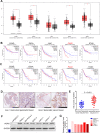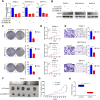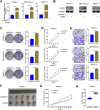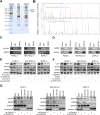Overexpressed WDR3 induces the activation of Hippo pathway by interacting with GATA4 in pancreatic cancer
- PMID: 33648545
- PMCID: PMC7923337
- DOI: 10.1186/s13046-021-01879-w
Overexpressed WDR3 induces the activation of Hippo pathway by interacting with GATA4 in pancreatic cancer
Abstract
Background: WD repeat domain 3 (WDR3) is involved in a variety of cellular processes including gene regulation, cell cycle progression, signal transduction and apoptosis. However, the biological role of WDR3 in pancreatic cancer and the associated mechanism remains unclear. We seek to explore the immune-independent functions and relevant mechanism for WDR3 in pancreatic cancer.
Methods: The GEPIA web tool was searched, and IHC assays were conducted to determine the mRNA and protein expression levels of WDR3 in pancreatic cancer patients. MTS, colony formation, and transwell assays were conducted to determine the biological role of WDR3 in human cancer. Western blot analysis, RT-qPCR, and immunohistochemistry were used to detect the expression of specific genes. An immunoprecipitation assay was used to explore protein-protein interactions.
Results: Our study proved that overexpressed WDR3 was correlated with poor survival in pancreatic cancer and that WDR3 silencing significantly inhibited the proliferation, invasion, and tumor growth of pancreatic cancer. Furthermore, WDR3 activated the Hippo signaling pathway by inducing yes association protein 1 (YAP1) expression, and the combination of WDR3 silencing and administration of the YAP1 inhibitor TED-347 had a synergistic inhibitory effect on the progression of pancreatic cancer. Finally, the upregulation of YAP1 expression induced by WDR3 was dependent on an interaction with GATA binding protein 4 (GATA4), the transcription factor of YAP1, which interaction induced the nuclear translocation of GATA4 in pancreatic cancer cells.
Conclusions: We identified a novel mechanism by which WDR3 plays a critical role in promoting pancreatic cancer progression by activating the Hippo signaling pathway through the interaction with GATA4. Therefore, WDR3 is potentially a therapeutic target for pancreatic cancer treatment.
Keywords: GATA4; Hippo signaling pathway; Pancreatic Cancer; WDR3; YAP1.
Conflict of interest statement
The authors have declared that no competing interest exists.
Figures








Similar articles
-
The short isoform of PRLR suppresses the pentose phosphate pathway and nucleotide synthesis through the NEK9-Hippo axis in pancreatic cancer.Theranostics. 2021 Feb 6;11(8):3898-3915. doi: 10.7150/thno.51712. eCollection 2021. Theranostics. 2021. PMID: 33664869 Free PMC article.
-
[Doublecortin-like kinase 1 activates Hippo pathway to promote migration, invasion and proliferation of pancreatic cancer cells].Zhonghua Zhong Liu Za Zhi. 2023 Jul 23;45(7):594-604. doi: 10.3760/cma.j.cn112152-20221222-00845. Zhonghua Zhong Liu Za Zhi. 2023. PMID: 37462016 Chinese.
-
Lysine demethylase 2 (KDM2B) regulates hippo pathway via MOB1 to promote pancreatic ductal adenocarcinoma (PDAC) progression.J Exp Clin Cancer Res. 2020 Jan 15;39(1):13. doi: 10.1186/s13046-019-1489-0. J Exp Clin Cancer Res. 2020. PMID: 31941533 Free PMC article.
-
LPA released from dying cancer cells after chemotherapy inactivates Hippo signaling and promotes pancreatic cancer cell repopulation.Cell Oncol (Dordr). 2025 Jun;48(3):655-671. doi: 10.1007/s13402-025-01038-9. Epub 2025 Feb 4. Cell Oncol (Dordr). 2025. PMID: 39903418 Free PMC article.
-
The developmental transcription factor Gata4 is overexpressed in pancreatic ductal adenocarcinoma.Int J Clin Exp Pathol. 2009 Aug 30;3(1):47-55. Int J Clin Exp Pathol. 2009. PMID: 19918328 Free PMC article.
Cited by
-
Unleashing the Power of Yes-Associated Protein in Ferroptosis and Drug Resistance in Breast Cancer, with a Special Focus on Therapeutic Strategies.Cancers (Basel). 2023 Dec 6;15(24):5728. doi: 10.3390/cancers15245728. Cancers (Basel). 2023. PMID: 38136274 Free PMC article. Review.
-
FATP5 modulates biological activity and lipid metabolism in prostate cancer through the TEAD4-mediated Hippo signaling.Front Oncol. 2024 Aug 19;14:1442911. doi: 10.3389/fonc.2024.1442911. eCollection 2024. Front Oncol. 2024. PMID: 39224804 Free PMC article.
-
Genome-wide association study of mammary gland tumors in Maltese dogs.Front Vet Sci. 2023 Oct 4;10:1255981. doi: 10.3389/fvets.2023.1255981. eCollection 2023. Front Vet Sci. 2023. PMID: 37859946 Free PMC article.
-
A novel prognostic model based on pyroptosis signature in AML.Heliyon. 2024 Aug 22;10(17):e36624. doi: 10.1016/j.heliyon.2024.e36624. eCollection 2024 Sep 15. Heliyon. 2024. PMID: 39263179 Free PMC article.
-
Development of a novel therapy for systolic heart failure.EMBO Mol Med. 2025 Aug 4. doi: 10.1038/s44321-025-00284-6. Online ahead of print. EMBO Mol Med. 2025. PMID: 40759792
References
-
- Sung H, Ferlay J, Siegel RL, Laversanne M, Soerjomataram I, Jemal A, Bray F. Global cancer statistics 2020: GLOBOCAN estimates of incidence and mortality worldwide for 36 cancers in 185 countries. CA Cancer J Clin. 2021. 10.3322/caac.21660. - PubMed
MeSH terms
Substances
Grants and funding
LinkOut - more resources
Full Text Sources
Other Literature Sources
Medical
Molecular Biology Databases
Research Materials

